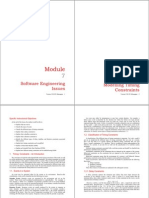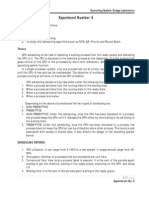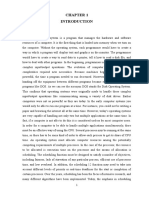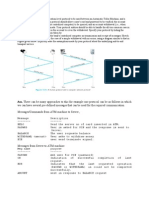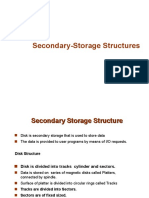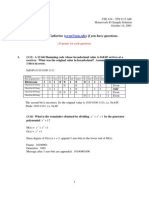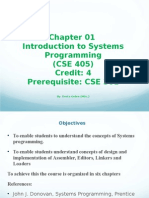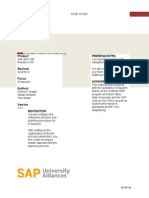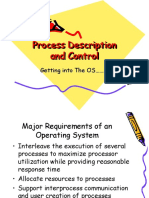Professional Documents
Culture Documents
Chapter - I: Implementation of Fcfs SJF SRT Cpu Scheduling Algorithm in Java
Chapter - I: Implementation of Fcfs SJF SRT Cpu Scheduling Algorithm in Java
Uploaded by
Rohit Kumar ChourasiaOriginal Description:
Original Title
Copyright
Available Formats
Share this document
Did you find this document useful?
Is this content inappropriate?
Report this DocumentCopyright:
Available Formats
Chapter - I: Implementation of Fcfs SJF SRT Cpu Scheduling Algorithm in Java
Chapter - I: Implementation of Fcfs SJF SRT Cpu Scheduling Algorithm in Java
Uploaded by
Rohit Kumar ChourasiaCopyright:
Available Formats
A Project Report On
IMPLEMENTATION OF FCFS,SJF,SRT CPU SCHEDULING ALGORITHM IN JAVA
Chapter I Introduction
1.1 INTRODUCTION
CPU SCHEDULING
It is the task of selecting a waiting process from the ready queue and allocating the CPU to it. It is a fundamental problem in operating systems in terms of minimizing the wait for the user when he or she simply wants to execute a particular set of tasks. In order to make the computer more productive in multiprogramming, the operating system needs to switch the CPU among processes
The scheduler is concerned mainly with:
CPU utilization: time utilized by CPU for a process. Throughput: The number of processes executed in a specified time period is called its throughput Turnaround Time: The amount of time that is needed to execute a process is called turnaround time. It is the actual job time plus the waiting time. Waiting Time: The amount of time the process has waited is called waiting time. It is the turnaround time minus actual job time. Response Time: The amount of time between a request is Submitted and the first response is produced is called response time
Overview
Scheduling algorithm CPU Utilization Throughput Turnaround Response Deadline handling Starvation free time time
First In First Out
Low
Low
High
Low
No
Yes
Shortest Medium remaining time
High
Medium
Medium
No
No
Fixed priority pre-emptive scheduling
Medium
Low
High
High
Yes
No
Round-robin scheduling
High
Medium
Medium
Low
No
Yes
Different algorithms are used for CPU scheduling. Such as FIRST-COME FIRST-SERVED SHORTEST-JOB-FIRST SHORTEST REMAINING TIME ROUND ROBIN PRIORITY SCHEDULING MULTILEVEL QUEUE SCHEDULING
Our project includes implementation of below algorithms in java FIRST-COME- FIRST-SERVED
With this scheme, whichever process requests CPU time first is allocated the CPU first. This is easily implemented with a FIFO queue for managing the tasks; as they come in, they're put on the end of the queue. As the CPU finishes each task, it pops it off the start of the queue and heads on to the next one. DRAWBACK- The average waiting time for this technique, though, is often quite long ADWANTAGE simple to implement
SHORTEST JOB FIRST
CPU is then given to the process with the minimal CPU burst from the waiting queue. SJF is provably optimal, in that for a given set of processes and their CPU bursts/execution times it gives the least average waiting time for each process. SJF algorithm may be preemptive or non- preemptive. A preemptive SJF algorithm will preempt the currently executing process, whereas a non-preemptive SJF algorithm will allow the currently running process to finish its CPU burst. Preemptive SJF scheduling is sometimes called shortest-remaining-time-first
SHORTEST REMAINING TIME
It is the preemptive version of shortest job first algo A preemptive SJF algorithm will preempt the currently executing process it is done with preemption of process comparatively long if any process comes with shortest burst time
Chapter II Literature Review
2.1 LITERATURE Traditionally, real time operating systems (RTOS) use scheduling mechanisms that Can provide predictable latency. Although this is a desirable property, attempts to Duplicate these designs in general purpose operating systems have not been fruitful (Geol. et al. 2004 [10]). General purpose operating systems have taken a different path in the development of schedulers. According to Goel et al. (2004) [10], Priority Scheduling assumes that the CPU needs of each thread are known and that the highest Priority thread voluntarily yields the CPU. Central processing unit (CPU) scheduling is the mechanism by which operating Systems (OS) allocate the CPU resources to processes. Scheduling is required for Multiprogramming, and it is one of the fundamental OS activities (As, 2005 [1]; Bar, 2000 [3]; Bovet and Cesati, 2003 [5]; Carpenter et al. [7]; Gorman, 2004 [11]; Love, 2004 [17]; Martin, 1999 [20]; Rinard, 1998 [28]; Silberschatz, 1998 [29]; Tannenbaum, 1992 [31]). Because, a scheduler aims to keep the CPU and input/ output (IO) systems as busy as possible, by overlapping processes undergoing IO bursts with processes undergoing CPU bursts, a process executed from bad or malicious code can affect the behavior of a scheduler and hence cripple computing (Kolivas, 2004 [13]; Martin, 1999 [20]; Miyoshi and Rajkumar, 2001 [21]; Oguma and Nakayama, 2001 [22]; Oyvind, 2004 [23]; Park and Choe, 2002 [24]; Regehr, 2002 [26]). The aim of a good scheduling algorithm is to maximize CPU utilization, CPU throughput, and scheduler efficiency; and to minimize queue turn-around-time, pro1 cess wait time, perceived response time, and variation in response times. The idea behind scheduling is based on a number of facts. First, process execution involves a cycle of alternating bursts. Second, CPU burst times cluster sharply. Third, CPUbound processes have many long CPU bursts. Last, IO-bound processes have many short IO bursts.
Chapter III Problem Identification
3.1 PROBLEMS Although context-switching is a desirable feature of OS CPU schedulers, it introduces dispatch latency. Excessive context-switching increases scheduler overheads. The current designs of scheduler algorithms allow bad or malicious code to exploit scheduler run time characteristics and induce high dispatch latency, keeping the scheduler perpetually busy and driving down CPU utilization.
Chapter IV Methodology
4.1 Software Hardware Requirement JAVA The Software Requirements are JAVA, MS EXCESS, Windows XP, Vista. The Hardware Requirements are minimum 512 MB RAM, centrino duo processor 4.2 SRS Document 4.2.1 Introduction 4.2.1.1 Purpose of this document To schedule the operating system process based on the fcfs, sjf,srtalgorithm s 4.2.1.2 Scope of this document The scope of this study was limited to the Linux scheduler and the Preemptive priority scheduling algorithm. At the evaluation phase, performance and stability characteristics were compared with those of the Linux 2.6.11 CPU scheduler. The C programming language was used in the development of the scheduler prototype. C has many desirable features, however there was not much of a choice since this is the language of the Linux kernel (Linen, 2000 [15]). The software development and tests were carried out on a single processor Intel architecture based personal computer.
4.2.1.3 Definitions, Acronyms and Abbreviations Srs Software Requirement Specification User a person who will be using the system for its intended purpose FCFS-First Come First Serve SJF-Shortest Job First SRT-Shortest Remaining Tim
The goals are: The goal is developa model CPU scheduler to guard against runway dispatch latency, and gurantee a optimum level of scheduler effiency 4.2.1.5 Overview 4.2.2 General Description
The remaining part of this document follows the IEEE STD 830-1993 format. Section 3 will cover the product perspective, functions, user characteristics, constraints and assumptions. Section 4 will cover the functional and non-functional requirements. Section 5 will cover the operational requirements.
4.2.2.1 Product Perspective The system will be developedusing JAVA 4.2.2.2 Product Functions To schedule the proceses of operating system CPU 4.2.2.3 User characteristics User will enter the number of process to be schedule, bursttime, arrival time 4.2.3 Requirements 4.2.3.1 Functional Requirements The user should be able to schedule the processes 4.2.3.1.1 Operation performed by user 4.2.3.1.1.1 Introduction Scheduling algorithm will schedule the process. 4.2.3.1.1.2 Inputs No. of process , burst time arrival time 4.2.3.1.1.3 Processing These will schedule the process. 4.2.3.1.1.4 Outputs Tur n around time,Average throught put, Waiting Time. 4.2.3.2 Interface Requirements 4.2.3.2.1 User Interfaces 4.2.3.2.1.1 The Command line Screen Input will be provided in command window. 4.2.3.2.1.2. Applet viewer window Output should be shown in this window 4.2.3.2.2 Hardware Interfaces All necessary hardware interfaces will be proided by the developer. 4.2.3.2.3 Software Interfaces The system shal be compatible to work as a applet window based application in JAVA .
4.2.3.3 Performance Requirements Burst time of process Arrival time 4.2.3.4 Design Constraints 4.2.3.4.1 Standard Compliance The IEEE format is used for technical documentation specification in this document. 4.2.3.4.2 Hardware Constraints The software system runs on Windows XP, Vista that requires minimum 1GB RAM and Centrino Duo Processor 4.2.3.4.3 Software Constraints (limitations) The system shall meet all performance requirements running on the JAVA application
4.3 DATA FLOW DIGRAM:
LEVEL 0
LEVEL 1
1st Level Data Flow Diagram (DFD)
(2) Display Input Form 1
User
Requests
(1) Scheduler
Invokes
Previous
Next
Datasets
Generates
(3) Display Input Form 2
Previous
Next
(4) Display Selection Form
LEVEL 2
Chapter V Results & Discussions
5.1 RESULTS FCFS input window :-
FCFS output window :-
FCFS Output
SJF output
Srt output
Chapter VI Conclusion & Scope of further Work
6.1 Scope The standard scheduling algorithms FCFS, SJF, RR, and Priority scheduling have formed the basis of industry application of CPU schedulers. The industry implementation of schedulers have employed variations based on flavours and hybrids of the standard algorithms. As with most NP-hard problems, in designing the standard algorithms, scholars did not concern themselves with security matters. They were interested in achieving optimization in certain process scheduling criteria e.g. throughput and responsiveness. Security, as often with software development became an issue when other inquisitive and / or malicious system developers got hold of the finnished products.
6.2 Conclusion Since context-switching is a costly necessity, it is important to keep its frequency to as minimum as possible. Malicious code can induce excessive context-switching by generating successive processes with increasing priorities. Linux implements a preemptive kernel. The most acclaimed advantage of the preemptive kernel is the protection it affords the OS. For instance, system calls are given high priority to enable them to execute ahead of other tasks. In this way they can reset failure points like race conditions and deadlocks. Systems with preemptive kernels have to contend with context-switching. The rational behind this study is that since the rates of both preemption and context-switches can be monitored, then either conditions to allow context-switching or preemption can be tied to the levels of the monitored statistics.
Bibliography
Website: www.google.com www.vbcodeguru.com http://cuinl.tripod.com/activex-7.htm http://www.vbtutor.net/lesson3.html www.rbi.org.in
You might also like
- Chrome OSDocument9 pagesChrome OSsmdieter0No ratings yet
- Vxworks Kernel Programmers Guide 6.9Document765 pagesVxworks Kernel Programmers Guide 6.9justnivasNo ratings yet
- Embedded IoT Assignment Answers TemplateDocument5 pagesEmbedded IoT Assignment Answers TemplateMuhannad TahaNo ratings yet
- Modelling Timing ConstraintsDocument7 pagesModelling Timing ConstraintsPuspala ManojkumarNo ratings yet
- 32-Bit Arm Cortex-M3 Lpc1768 Microcontroller Block DiagramDocument3 pages32-Bit Arm Cortex-M3 Lpc1768 Microcontroller Block Diagramsiva kumaarNo ratings yet
- Cpu Scheduling AlgorithmDocument3 pagesCpu Scheduling AlgorithmSeaton HarnsNo ratings yet
- Creating A Registration Form Using PHPDocument11 pagesCreating A Registration Form Using PHPGorakhnath MethreNo ratings yet
- RTES Chapter4&5 Design Issue&Real Time CommunicationDocument24 pagesRTES Chapter4&5 Design Issue&Real Time Communicationyaikob iyasuNo ratings yet
- CPU Scheduler Simulation ReportDocument20 pagesCPU Scheduler Simulation Reportsajjad100% (1)
- Introduction To Computers (Question Bank)Document9 pagesIntroduction To Computers (Question Bank)SumitembhareNo ratings yet
- Disk Performance OptimizationDocument56 pagesDisk Performance OptimizationSenthildevi K.ANo ratings yet
- Requirements Modelling StratigiesDocument74 pagesRequirements Modelling StratigiesHarsha PaniaNo ratings yet
- Quantitative Principles of Computer DesignDocument10 pagesQuantitative Principles of Computer Designmillan100No ratings yet
- Timers, Serial Port & Interrupts in 8051Document51 pagesTimers, Serial Port & Interrupts in 8051Sureka N Assistant Professor - ECENo ratings yet
- Non Regular LanguageDocument25 pagesNon Regular LanguageJibran ElahiNo ratings yet
- Disk Scheduling Algorithms in OsDocument32 pagesDisk Scheduling Algorithms in OsRaghu NixelNo ratings yet
- Cellular IPDocument21 pagesCellular IPramya sreeNo ratings yet
- Haramaya University: Collage of Computing and Informatics Department of Information TechnologyDocument36 pagesHaramaya University: Collage of Computing and Informatics Department of Information Technologyamsalu alemuNo ratings yet
- TOPIC 1.1 - Server Operating SystemsDocument7 pagesTOPIC 1.1 - Server Operating SystemsFathie HeadshotYouNo ratings yet
- Shift Register and Its TypesDocument22 pagesShift Register and Its TypeschoprahridyeshNo ratings yet
- Digital Electronics & Computer OrganisationDocument17 pagesDigital Electronics & Computer Organisationabhishek125No ratings yet
- Parallel Algorithm - IntroductionDocument36 pagesParallel Algorithm - IntroductionTejodeep BoseNo ratings yet
- Chapter 6 8086 Hardware Specifications PDFDocument42 pagesChapter 6 8086 Hardware Specifications PDFseiyfuNo ratings yet
- Embedded System: Real-Time Operating SystemsDocument44 pagesEmbedded System: Real-Time Operating SystemsSamuel Adamu100% (1)
- DHCP Server - 27 Interview Questions and Answers PDFDocument6 pagesDHCP Server - 27 Interview Questions and Answers PDFNaveen Adaikkalam100% (1)
- Computer Fundamentals: Lab Report # 5Document7 pagesComputer Fundamentals: Lab Report # 5Fariha SaeedNo ratings yet
- WT-web Technology AkashDocument54 pagesWT-web Technology Akashshubham moudgilNo ratings yet
- Virtualization For Data-Center AutomationDocument3 pagesVirtualization For Data-Center Automationupkar computerNo ratings yet
- Dem 22421 Ut2 QB 070320Document3 pagesDem 22421 Ut2 QB 070320yashpatil0154100% (1)
- Assignment Questions For M.SC Second Year First Semester Students Course: Distributed Systems: Submission Date: Jan 29Document1 pageAssignment Questions For M.SC Second Year First Semester Students Course: Distributed Systems: Submission Date: Jan 29AlexNo ratings yet
- CPU SchedulingDocument39 pagesCPU SchedulingGãürãv DübëyNo ratings yet
- 3.modeling Timing ConstraintsDocument43 pages3.modeling Timing ConstraintsPrathamesh Gujar100% (1)
- Module 01 - Introduction To Computers PDFDocument35 pagesModule 01 - Introduction To Computers PDFTsokolate Choknat100% (2)
- Sample Solutions Unit Test 1 For Set A, B, C and DDocument33 pagesSample Solutions Unit Test 1 For Set A, B, C and DPratiksha KambleNo ratings yet
- 5.1 RaidDocument14 pages5.1 Raidgidum2007100% (1)
- Sequential Circuit: Shreyas Patel M.Tech VLSI Design (VIT, Vellore) SVNIT, SuratDocument21 pagesSequential Circuit: Shreyas Patel M.Tech VLSI Design (VIT, Vellore) SVNIT, SuratMudit SandNo ratings yet
- Li-Fi Proposal PDFDocument4 pagesLi-Fi Proposal PDFMahmoud AbuzayedNo ratings yet
- WTA (Wireless Telephony Application)Document6 pagesWTA (Wireless Telephony Application)deepana jayaNo ratings yet
- Advantages of Proposed SystemDocument3 pagesAdvantages of Proposed System4JN19CS408 Shreelakshmi cNo ratings yet
- Assignment 3 FinalDocument3 pagesAssignment 3 FinalRizwan Aslam ButtNo ratings yet
- FINAL2Document14 pagesFINAL2Tariku MantafoNo ratings yet
- UNIT III - Embedded Firmware Development EnvironmentDocument19 pagesUNIT III - Embedded Firmware Development EnvironmentKALAIVANINo ratings yet
- Project Cost Estimation PDFDocument51 pagesProject Cost Estimation PDFlollolNo ratings yet
- Unit Iv Rtos Based Embedded System DesignDocument11 pagesUnit Iv Rtos Based Embedded System DesignKartheeswari Saravanan100% (1)
- Project Documentation Team L 1Document19 pagesProject Documentation Team L 1Rodelynn Padua100% (1)
- Lecture 2 Fundamental Steps in Digital Image ProcessingDocument4 pagesLecture 2 Fundamental Steps in Digital Image ProcessingAaqib IhrazNo ratings yet
- The Network Devices FunctionDocument2 pagesThe Network Devices FunctionJhea ArponNo ratings yet
- What Is A Process Scheduler? State The Characteristics of A Good Process Scheduler? Which Criteria Affect The Schedulers Performance?Document6 pagesWhat Is A Process Scheduler? State The Characteristics of A Good Process Scheduler? Which Criteria Affect The Schedulers Performance?partha deyNo ratings yet
- Chapter 3-Part IIDocument26 pagesChapter 3-Part IIAbebaw Gebre100% (1)
- Operating Systems-1Document24 pagesOperating Systems-1M Jameel MydeenNo ratings yet
- Unit 6 - Secondary Storage StructuresDocument23 pagesUnit 6 - Secondary Storage StructuresNishant NalawadeNo ratings yet
- Interrupts 8051 MicrocontrollerDocument25 pagesInterrupts 8051 Microcontrollerबृजभूषणशर्माNo ratings yet
- 434 HW 3 SolDocument5 pages434 HW 3 SolSweet AliaNo ratings yet
- Risc and CiscDocument17 pagesRisc and CiscAyazNo ratings yet
- Concept of Frequency Reuse ChannelsDocument6 pagesConcept of Frequency Reuse ChannelsNamrata DhamalNo ratings yet
- William Stallings Computer Organization and Architecture 9 EditionDocument40 pagesWilliam Stallings Computer Organization and Architecture 9 EditionAdnan Aslam MerchantNo ratings yet
- Round Robin TechniqueDocument33 pagesRound Robin TechniquevedaNo ratings yet
- Embedded System Assignment 1Document1 pageEmbedded System Assignment 1Vijayaraghavan AravamuthanNo ratings yet
- Chap 4 CPU SchedulingDocument21 pagesChap 4 CPU Scheduling飞翔No ratings yet
- Report OSY NikhilDocument29 pagesReport OSY Nikhilhitup292No ratings yet
- Kapil Sai PagadalaLab3Document8 pagesKapil Sai PagadalaLab3ram jiNo ratings yet
- Algorithm Psudo Code For Scheduling Algorithm PDFDocument7 pagesAlgorithm Psudo Code For Scheduling Algorithm PDFsankrajegowdaNo ratings yet
- Mastering Linux Kernel DevelopmentDocument346 pagesMastering Linux Kernel Developmentatom tux100% (2)
- Enc Encoded Dc3vMmJGfW5vNkK3M9CI 08ah9nDOxMOf0T7UR43m8ndq TykHR8pADocument32 pagesEnc Encoded Dc3vMmJGfW5vNkK3M9CI 08ah9nDOxMOf0T7UR43m8ndq TykHR8pAfawad jawadNo ratings yet
- Disk ProblemDocument6 pagesDisk ProblemArif MunandaNo ratings yet
- SPPU TBSC CS Syllabus 2021 22 PDFDocument60 pagesSPPU TBSC CS Syllabus 2021 22 PDFSHWETA GANGURDENo ratings yet
- Case StudyDocument17 pagesCase StudySumeet KaurNo ratings yet
- Introduction To Systems Programming (CSE 405) Credit: 4 Prerequisite: CSE 301Document25 pagesIntroduction To Systems Programming (CSE 405) Credit: 4 Prerequisite: CSE 301Stricker ManNo ratings yet
- Linux Architecture - 1Document34 pagesLinux Architecture - 1Paresh TannaNo ratings yet
- Operating Systems: Bea May M. Belarmino Joselle A. Banocnoc Khryss Leanne B. OmnesDocument48 pagesOperating Systems: Bea May M. Belarmino Joselle A. Banocnoc Khryss Leanne B. OmnesMa. Pamela Jao SaguidNo ratings yet
- Phase IV - Production - MasterDocument177 pagesPhase IV - Production - MasterAshish BooraNo ratings yet
- Process Description and ControlDocument54 pagesProcess Description and Controler_mjk_ec100% (1)
- Operating Systems: CPU SchedulingDocument12 pagesOperating Systems: CPU SchedulingRichi DubeyNo ratings yet
- Term Project: Jannat Rehman F2018266200 Topic: FCFS Section: W1Document5 pagesTerm Project: Jannat Rehman F2018266200 Topic: FCFS Section: W1Aden TahirNo ratings yet
- Section 10E: Float Times and The Critical Path - 3 New Level 3 QuestionsDocument5 pagesSection 10E: Float Times and The Critical Path - 3 New Level 3 QuestionsA. ZNo ratings yet
- Linux MaterialDocument111 pagesLinux MaterialVeena GowdaNo ratings yet
- Batch Man - Batch ProcessingDocument18 pagesBatch Man - Batch ProcessinglijinowalNo ratings yet
- CP 226 Cpu Scheduling AssignmentDocument6 pagesCP 226 Cpu Scheduling Assignmentwell responsiveNo ratings yet
- 1276 1663932836 CC Module IIDocument64 pages1276 1663932836 CC Module IIARCHITHA MOL UK RMCA 2021-2023 ANo ratings yet
- Assignment Ch1Document4 pagesAssignment Ch1Ashraf Seif El-NasrNo ratings yet
- BE Syllabus Chandigarh UniversityDocument114 pagesBE Syllabus Chandigarh Universitykashishbhatia50% (2)
- Advances in Big - littLE Technology For Power and Energy SavingsDocument11 pagesAdvances in Big - littLE Technology For Power and Energy SavingsChristine AvdikouNo ratings yet
- SIMAN Simulation of Assembly Operations in A Furniture CompanyDocument11 pagesSIMAN Simulation of Assembly Operations in A Furniture CompanyNacsa JánosNo ratings yet
- Operating System SyllabusDocument2 pagesOperating System SyllabusAnonymous BMRvsO4No ratings yet
- CS571 Lecture4 Scheduling PDFDocument39 pagesCS571 Lecture4 Scheduling PDFHadcjj ManNo ratings yet
- 03 Stacks Queues 6 LabsDocument56 pages03 Stacks Queues 6 LabsĐăng Khoa Đỗ DươngNo ratings yet
- OS Interview NotesDocument18 pagesOS Interview NotesAishwarya JanardhanNo ratings yet
- Disk Scheduling Algorithms - GeeksforGeeksDocument12 pagesDisk Scheduling Algorithms - GeeksforGeeksummemariyashah526No ratings yet
- 4.CPU Scheduling and Algorithm-NotesDocument31 pages4.CPU Scheduling and Algorithm-NotesSpNo ratings yet
- LTE Optimizing The PDCCHDocument10 pagesLTE Optimizing The PDCCHmuhammad riezaNo ratings yet



